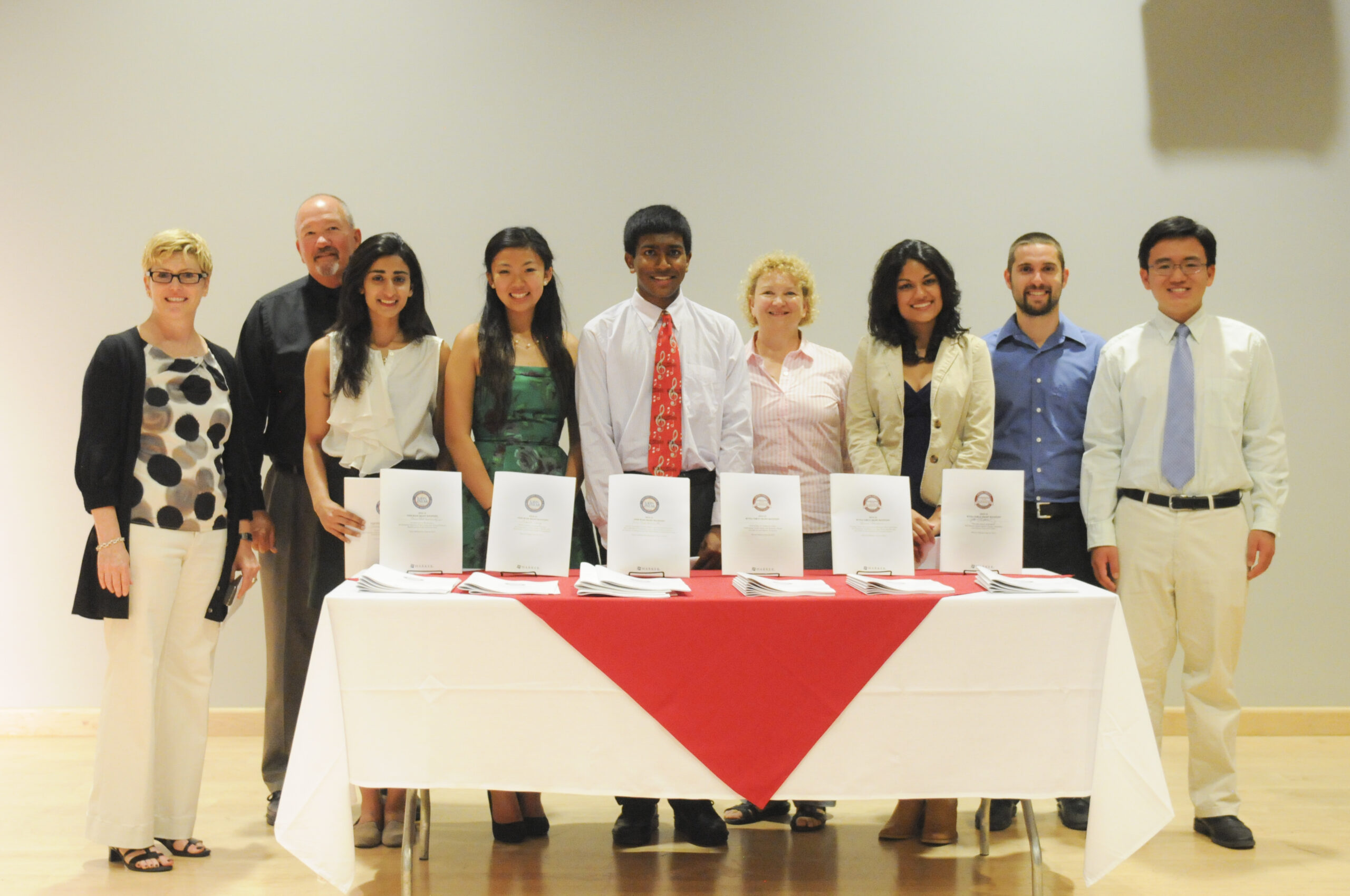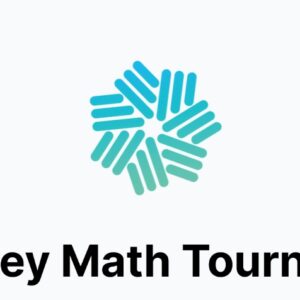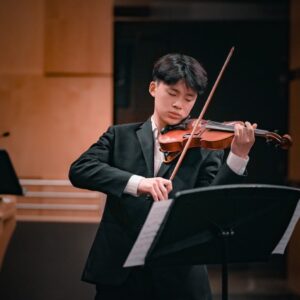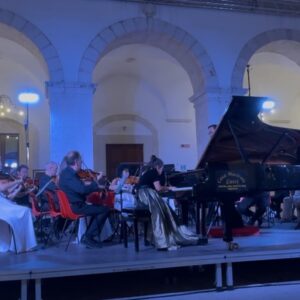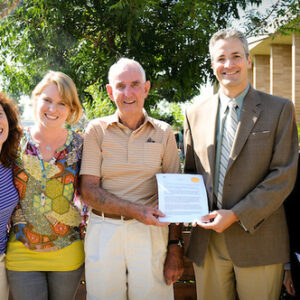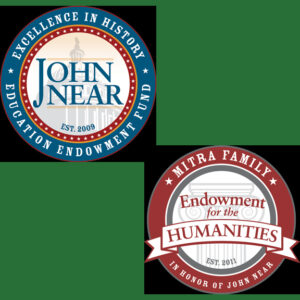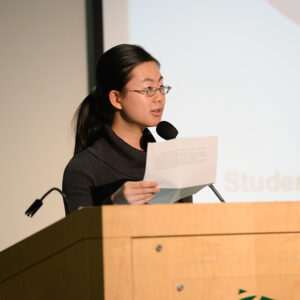This article was originally published in the fall 2014 Harker Quarterly.
Since their foundings in 2009 and 2011, respectively, the John Near history endowment and the Mitra humanities endowment have become symbols of the Harker community’s dedication to helping students pursue a broad array of interests. The endowments have funded 21 meticulously researched historical analyses to date.
Established after the 2009 passing of beloved history teacher John Near and funded by his parents, Jim and Pat Near, The John Near Excellence in History Education Endowment echoes Near’s passion for history education. In addition to funding the continued development of the John Near Resource Center, the endowment provides students with opportunities to do high-level academic research on their chosen historical topics.
Two years later, Harker parents Samir and Sundari Mitra (Sachin ‘10; Shivani ‘13) established The Mitra Family Endowment for the Humanities, a $100,000 fund that further expands research opportunities into areas such as philosophy, languages and the arts. This endowment exemplifies the Mitras’ “whole mission” philosophy, which emphasizes not just mathematical and scientific know-how but also the ability to know what people need, “so that you can create something to help make the world a better place,” said Joe Rosenthal, executive director of advancement.
Each year, Harker seniors submit proposals on topics in history and the humanities that they would like to explore. Those chosen to receive Near and Mitra grants are then assigned a faculty mentor and spend the next year researching and writing their papers. Their journeys often lead to fascinating discoveries. Shivani Mitra, one of the first Mitra scholars, traveled to Mexico City to speak with members of Frida Kahlo’s family for her project on the life and impact of the legendary painter and feminist icon. She also unearthed archival photos that provided further insight into Kahlo’s life and how it influenced her work.
“We had so much fun,” said history department chair Donna Gilbert, who mentored Mitra during her research. “Neither of us had seen any of those archival photographs before.”
Gilbert and Library Director Sue Smith, who evaluate and approve student proposals for the grants, admitted to trepidation about the programs upon their initial launch. “That first year, we kind of held our breath; we weren’t sure if anyone was even going to want to do it,” Gilbert said.
“Are they going to line up to do independent research in their senior year that’s going to take hours and hours of their time?” Smith remembered asking at the time.
Their concerns were allayed both by the response to the grant programs, which attracted dozens of applicants this past school year, and the quality of the resulting papers. Students have begun asking about the grants as early as grade 9, “and not just as a resume builder, but with a genuine interest in a topic,” Gilbert said.
The grant programs also have acted as a source of professional development for the faculty mentors, who often find themselves caught up in the subjects that the students are studying. “We’re all intellectually interested ourselves,” Smith said. “I’ve watched mentors do research simultaneously with the kids to stay one step ahead so that they can help them.”
Just this summer, Smith bumped into Apoorva Rangan, grade 12 and one of this year’s Near scholars, and found herself in a conversation about Rangan’s research on news coverage of the Vietnam War and the resulting tension between news media and the federal government. The discussion turned to how Rangan planned to focus her project after learning how the Freedom of Information Act affected television coverage of the war. “She’s seeing things in history colliding and questioning what affected what,” Smith said. “Those kinds of things sustain those of us in education for weeks at a time.”
For Rangan, the importance of the Near and Mitra grants lies in how they reinforce Harker’s mission to help students discover and foster their love for any topic. “The grants haven’t just enhanced learning opportunities for the scholars,” Rangan said. “They’ve helped bring balance to the entire student body. They’ve helped emphasize to students that you can make any subject as rigorous as you want it to be.”
The grants also provide additional motivation for students to excel in social studies and the humanities, something to which Rangan can personally attest. “When I was thinking about proposal topics for the grant, I found myself more involved and engaged in my history classes,” she said.
In their proposals, students frequently cite work they have done in previous years, Smith said. “Oftentimes they provide a resume in their application for the grant,” she said. “The point is that they see our research scope and sequence in the history department as preparation.”
The effort and passion that goes into these projects also can have lasting effects that extend far beyond the students’ high school careers. While working on her paper about the impact of the feminist and civil rights movements on the disability rights movement of the 1960s and ’70s, Near scholar Zina Jawadi ’13, who is hearing impaired, also began devising a plan for how to improve the lives of people with disabilities, particularly the removal of barriers to educational opportunities.
For Jawadi, one of the greatest benefits of being a Near scholar was the mentorship she received from Smith and history teacher Ruth Meyer, both of whom offered advice on how to create a paper that would bolster her long-term goals. “Dr. Meyer and Ms. Smith mentioned in my first meeting in senior year that I should focus on the history of the disability rights movement rather than the policy change,” she said.
“Dr. Meyer then explained that the policy change paper could have more of an impact in the real world, if I published [it] in a few years, once I have established my advocacy work, and once I have solidified my [knowledge of the] historical background of the disability rights movement.”
Though they are happy with the grant programs as they currently exist, Gilbert and Smith have discussed some possible future improvements. Gilbert would like to see Near and Mitra scholars share and discuss their work with the community more often, hoping that “students will see research not necessarily as a burden or as … just another assignment that they have to check off, but [as] transformative.”
Another possibility is adding more multimedia elements, such as links to videos or sounds embedded into the electronic versions of the papers. “When somebody interviews Frida Kahlo’s family, it would be fabulous to be able to have a video clip embedded in the paper,” Smith said.
Above all, Gilbert and Smith hope that the grants continue in their mission to offer research opportunities to students who wish to explore the subjects they love.
“I feel like we are so in touch with the kids’ interests and can support them in this program,” Smith said. “This is the ultimate individualized learning program.”
Mitra and Near Scholar papers have all been summarized and the summaries can be found in Harker News at news. harker.org; search “endowment.” The papers themselves can be found on our website at http://library.harker.org/nearmitra.
